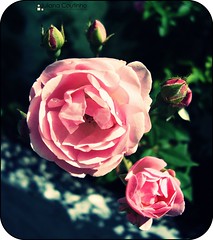 Image by Juliana Coutinho via Flickr
Image by Juliana Coutinho via Flickr----------
Pre-set modes like "Sports" and "Night Portrait" make it easy for us to just point and shoot. If you're new to photography, two of the most important things to learn are aperture and shutter speed settings as these will give you a lot of creative control. If you're not sure which cameras have these types of settings, some compact digital cameras have them but most bridge cameras and all DSLRs have them.
At first it may seem it a little confusing using manual camera settings, but the improvement in the quality of your pictures wil be well worth it.
Photography 101 - Learning About Camera Aperture

Aperture lets the photographer (or the camera's exposure computer if it's set to automatic) increase or reduce the amount of light that gets through to the sensor, thus helping determine how bright or dark the picture will be.
The aperture also controls the depth of field of the image.

A small aperture is good for taking pictures where you want it all in focus, like a landscape.
When you use your camera's Aperture Priority setting you can set the aperture to whatever f-stop number you want. These numbers represent ratios, and the larger the f-stop number, the narrower the aperture. So when the f stop setting is larger on your camera, then there will be a larger depth of field.

Photography 101 - Introducing Shutter Speed
While the aperture controls how much light at one time falls on the image sensor, the shutter speed controls the length of time the camera allows in the light.
If you've ever seen really old pictures, you'll notice that they are rarely smiling. Shutter speeds used to be so slow that people would have to remain very still for several minutes in the early days of photography. No wonder they had such a serious look!

If you use a shutter speed slower than 1/60, you should use a tripod or some type of camera stabilizer because when the shutter is open that long, even the slightest jiggle can create fuzzy pictures.
To freeze action, set the camera's Shutter Priority to a fast speed, which is what Sports mode does. You can be a lot more selective with this manual type of setting. For example, a dog sitting quietly will require a shutter speed of around 1/125 in order to freeze the small twitch in the dog's tail. On the flip side, taking pictures at a soccer game may require up to 1/500 to freeze fast moving actions.

Autumn Lockwood is a writer for Your Picture Frames and loves taking pictures. Shop our online picture frame selection and see our large selection of picture frames in a wide variety of styles, sizes and unique shapes like our decorative round picture frames.
Article Directory: EzineArticles
----------



![Reblog this post [with Zemanta]](http://img.zemanta.com/reblog_e.png?x-id=daa79ed8-aeda-466f-a5f6-d7d5cd8d17e2)
No comments:
Post a Comment